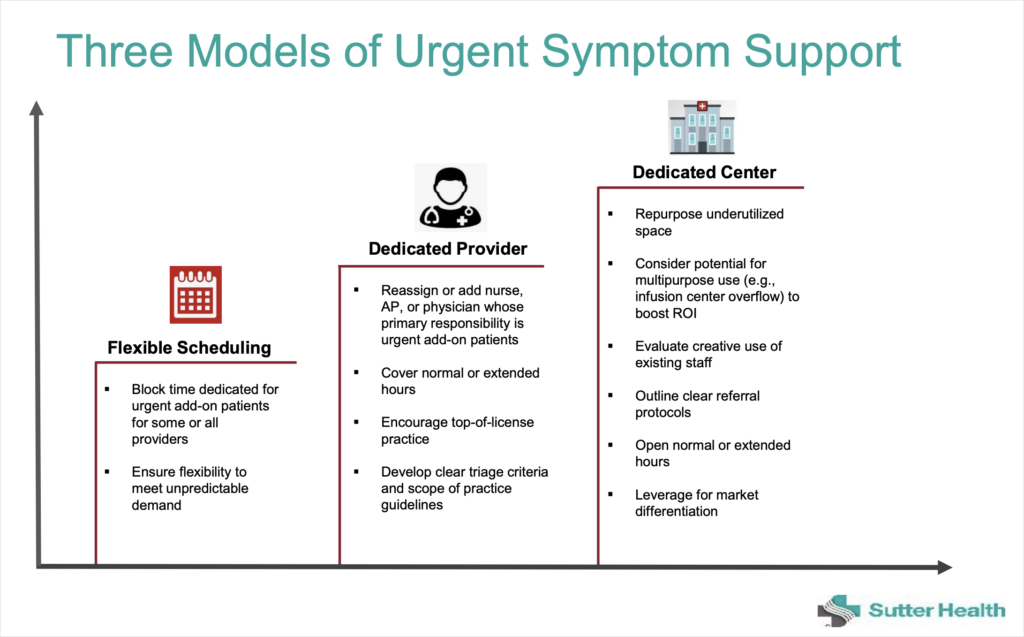Reducing avoidable emergency department visits and hospitalizations for cancer patients continues to be a challenge for many providers in the shift to value-based care. In light of today’s health crisis with the COVID-19 pandemic, it’s become even more important to keep patients away from hospitals if possible. It’s not only very costly – it’s the wrong setting for an immunosuppressed patient to be waiting for care.
At this year’s ACCC 46th Annual Meeting & Cancer Center Business Summit, Mike Koroscik, the Oncology Service Line Executive for Sutter Health, shared insights including:
- How to develop key questions and tactics to address oncology urgent care
- Strategies to improve symptom management
- Various models of Urgent Symptom Support
These topics align closely to what we have heard from other organizations including the Advisory Board’s Oncology Roundtable, University of Pennsylvania and Stanford Cancer Institute. It’s also central to what we are focused on here at Navigating Cancer. For Sutter Health, Mike saw the need to examine urgent care use as an important factor in keeping up with the constant change in oncology care – from new treatments, reimbursement changes, what comes after OCM, and more.
Key Questions and Tactics to Address
He examined several areas to identify opportunities for improvement including early adopter models, clinical care variation, and emergency department utilization 30 days following chemotherapy. Sutter Health used all of that information to fine tune operational processes, to share data proactively with payers, and rethink investment strategies regarding technology as he looks ahead at alternative payment models.
To begin to address ED utilization, Sutter Health collaborated with primary care physicians and emergency department physicians to provide some added education, which they called Oncology 101, to prepare providers who are specially trained to see oncology patients. They also began exploring other solutions including dedicated emergency services, triage, after hours care and that work served as the base for a business plan.
They looked at the utilization data for California for recently diagnosed cancer patients:
- 16% used the ED within 30 days of diagnosis
- 35% within 6 months of diagnosis
- 44% within 1 year of diagnosis
Mike shared in researching this topic he found that cancer patients are twice as likely to use the emergency department than the general population in the United States and only 3 cancer programs currently have emergency departments offering 24/7 care.
Best Practices for Symptom Management and Urgent Symptom Support
In order to figure out how to reduce this utilization, Sutter Health looked at metrics like volume, reasons, utilization times, tumor sites, comorbidities, and others. He used that to build the case for competencies needed to keep patients out of the ED.
Over 6 months at Sutter Health there were 567 ED encounters for 344 unique patients. For those they tracked the chief complaints, primary diagnoses, significant cost drivers including imaging, and reasons for hospitalization.
The result was a rich database for Sutter Health to look at stages of therapy, address internal issues, transform the nurse navigation program, and proactively prevent return visits.
The best practices emerged:
- Identify the drivers or avoidable ED and hospital utilization
- Make it easy for patients to report their symptoms to their care team
- Dedicate resources to manage urgent symptoms in the cancer center
Mike share three models for urgent symptom support:

- Flexible Scheduling – Offer extended hours, same day appointments and educate the patient to avoid the ED if possible and contact the clinic instead.
- Dedicated Provider – Ensure patients can always see a qualified provider especially when you are seeing the most utilization.
- Dedicated Urgent Care – can you repurpose under-utilized space or collocate some services? This will not only be better for patients it also is a considerable market differentiation.
In today’s COVID-19 healthcare crisis, cancer care providers have an even greater need to keep patients safe at home. Navigating Cancer’s technology is effective for remote monitoring and symptom management. The care team can use the same workboard in the clinic or from their homes. They can assist patients, monitor symptoms, and provide follow up home care instructions delivered via SMS text or email right to the patient and their caregivers. Contact us to learn more.
